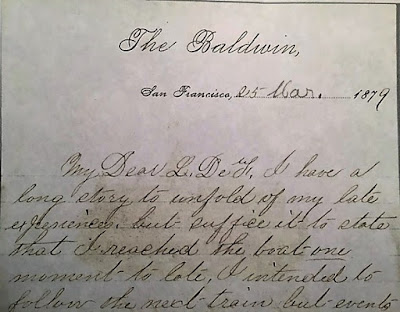 |
| Josephine Walcott, 1860s |
Both native New Englanders,
they might have met in New Hampshire or Vermont. But John Walcott went out to Magnolia,
Illinois, in 1848 to build houses and a full ten years passed before Josephine Butterfield joined
him and they married.
John enlisted in the 77th
Illinois Regiment and fought for the Union in Tennessee and Mississippi.
Josephine made her way to Chicago to sit for a photograph. Three children were
born during the war years: Earle, Mabel, and Maude.
The children were smart but
Earle turned out to be sickly, so his mother taught him at home. The family
moved to Santa Barbara in 1868, hoping the climate would improve Earle’s
health. A precocious child, he founded and edited the Santa Barbara Weekly Tribune which he published for a few years.
Josephine began to write poetry.
In 1871, a new magazine
called Overland Monthly published her
poem, “Almost.” Encouraged, she wrote more and also published under the name
Cordelia Havens. Several anthologies included her work and critics considered
her a California poetess. A review of her collection, World of Song, cited “clear thought, delicate imagination, good
command of emotional sentiment and a felicitous Tersifloation.”
Tersifloation seems to relate
to phrasing but that’s all I can figure out. A beautiful word, though!
It’s clear that Josephine
pushed her children toward higher education. They enrolled at Santa Barbara
College to prepare for the University of California, Berkeley, from which all
three would graduate. Around that time, Josephine may have had an affair with
William Hollister, owner of a grocery where John Walcott worked as a manager. Hollister
or someone else may have been the father of Marion Queenie, Josephine’s fourth
child who came along in 1882 in San Francisco.
Several years after Queenie’s
birth, John and Josephine filed for divorce but the relationship must have been
very bitter because the court assigned a judge to referee. By then, she and her
husband occupied entirely different worlds.
Josephine fit perfectly into
her time or perhaps the time suited her especially well. How fortuitous that she
arrived in California just as it came into its own art, literature, and politics:
the emergence of a distinctive California ethos. For she was a seeker and it
came naturally to embrace new ideas.
As
an advocate of woman’s suffrage, Josephine wanted to shake off male domination.
And, like many suffragists,
Josephine was a late Victorian spiritualist. The two may seem incongruous. Yet
one of the major ways to escape patriarchy was to step away from conventional
religion. Historians have long explored how women spiritualists, while
communicating with the dead, developed a commitment to social justice including
the 19th century women’s rights movement. It is thought that public
performance boosted their confidence, honed their speaking skills, and exposed
them to issues involving women and children.
In
1874, Josephine co-founded the Freethought Committee of California. Freethought
went hand in hand with spiritualism; its appeal to logic and reason excluded
religious dogma. The same year, Josephine helped organize the Santa Barbara
Spiritualist Association and became its vice president, bringing famous mediums
to speak while the group was denounced for promoting fornication, suicide,
desertion, adultery, divorce, dementia, prostitution, abortion, and insanity.
I
guess it hit a nerve.
Josephine delivered a
lecture, “The Truth Shall Make You Free,” before the Santa Barbara Spiritualist
Association in 1876. An observer commented:
Of Mrs. Walcott, it was said
that her enunciation was clear and pleasant, though a little too rapid for slow
thinkers, for her grand ideas were clothed in so few words, and followed so
rapidly, like booming waves, one after another, upon a storm-beaten shore, that
there were some who could not gather, arrange, and enjoy the beautiful pearls
as they fell from her lips.
Even at this distance, the
lecture holds up. Citing Galileo, Luther, Franklin, Morse, Darwin, and Huxley,
Josephine championed empiricism and declared: “Women are but dimly conscious of
their power, so circumscribed are their limits. . . Woman must be free,
independent, self-reliant and individualized.”
See also: November 4 + 11 + December 2, 2015 posts; January 12 + 16 posts.
https://www.throughthehourglass.com/2015/11/enter-josephine-walcott.html




















